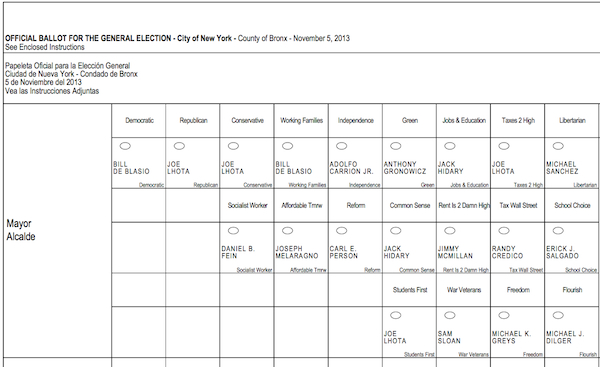
Photo by: NYC BOE
A government watchdog group that will be running a voter helpline during Tuesday’s election is anticipating complaints about the six-point font that will be used on the ballots.
“It’s disenfranchising in and of itself for voters who have sight issues or people who have trouble reading,” says Neal Rosenstein, government reform coordinator at the New York Public Interest Research Group (NYPIRG), which will be operating a voter helpline Tuesday.
“You gotta bring your glasses, if you own them,” Rosenstein says.
The New York City Board of Elections is standing by its decision to print the ballots in six-point font, but will try to make it easier for voters who have trouble seeing the small print, a city official says.
Elected officials and voter advocates have been criticizing the small print on the ballot ever since the ballot was unveiled on Oct. 15, three weeks before the election.
The Board of Elections said it was using the six-point font in order to accommodate all of the languages required by law – English, Spanish, Chinese, Korean and Bengali – on a single-page ballot.
Valerie Vazquez, communications director of the city’s Board of Elections, says the ballots could not be printed in bigger font because larger paper would not be compatible with the scanners. Only the New York State Board of Elections could change the planned method, she adds.
Poll sites will provide magnifying sheets and ballot-marking devices that can enlarge the text up to 22-point font, she says. Voters should also visit the board’s website to become familiar with the ballot in advance, she says.
Posters that are five times larger than the ballots will also be displayed at poll sites, she notes.
But watchdog groups said the small font will discourage voters.
“There is no good reason for subjecting voters to such difficulties,” Susan Lerner, executive director of Common Cause New York, said in a statement last month. “It is past time for NYC’s elections to join the 21st century.”
Common Cause believes the board should accommodate all languages by using a readable font on multiple ballots, a spokesperson said.
“This has been a known problem for years and the state legislature has refused to pass some common sense reforms that would simplify and allow ballots to be more easily comprehended,” Rosenstein, of NYPIRG, says.
The ballots could have been printed with text in only the main languages of each neighborhood, he says. Such a measure would not result in extra costs, he adds.
Vazquez, the Board of Elections communications director, says the agency is also responding to voters’ complaints about lever machines used in the September primary elections. In one polling place in the Bronx, a lever machine had no levers for several candidates. In other polling sites throughout the city, voters reported jammed and broken machines.
“We’re using new machines.” Vasquez says. “We’re not using levers.”
Each scanner has been tested and is ready for use on Tuesday, she adds.
The lever machines were used in the September primary due to concerns there would not be enough time to round up and dispatch the scanners for the run-off election.
The board reported a 4.3 percent failure rate with the lever machines in 2009 and plans on releasing data for this year in January, Vazquez says. The broken machines were spread out equally across New York City, she says.
Rosenstein, the government reform coordinator at NYPIRG, estimates that one voter out of 60 used an emergency paper ballot due to lever machine problems in September.
“If you were running a restaurant, and one out of every 60 people got food poisoning, you’d be out of business,” Rosenstein says. “That number is pretty unacceptable.”
Voters can report problems at Tuesday’s polls by calling NYPIRG’s hotline number, 212-822-0282.







